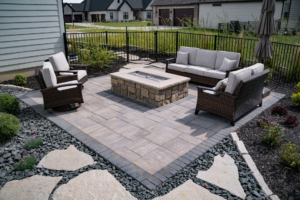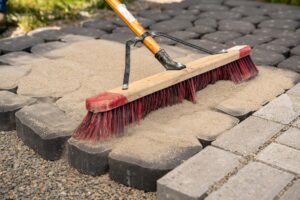Does polymeric sand harden like concrete? For anyone who’s dreamt of a beautiful, low-maintenance patio, pavers are a fantastic choice; but the job isn’t quite done after laying those stunning stones!
The spaces between the pavers, called joints, need to be filled with a material that keeps them locked in place, prevents weed growth, and allows for proper drainage. This is where polymeric sand comes in – and what this article is all about.
But before we delve into the world of polymeric sand, let’s address the burning question:
Does polymeric sand harden like concrete?
The answer to whether polymeric sand hardens like concrete is not a simple yes or no. Polymeric sand cures into a firm, stable substance – but unlike concrete, it doesn’t form a rigid, monolithic structure. Here’s a breakdown of the key differences:
Bonding
Concrete hardens through a chemical reaction called hydration, where water activates the cement and binds the sand, gravel, and other components together. Polymeric sand, on the other hand, uses a resin binder that activates with water, creating a strong adhesion between the sand particles and the paver edges.
Flexibility
Concrete is a rigid material, prone to cracking under pressure or movement. Polymeric sand retains a degree of flexibility, allowing for slight shifts in the pavers due to freeze-thaw cycles or ground settling without cracking.
So the answer to if polymeric sand hardens like concrete is “no” – but that is not a bad thing! In summary, while polymeric sand provides a stable and flexible solution for paver joints, it does not achieve the same level of hardness and strength as concrete. Instead, it offers a balance between firmness and flexibility, making it suitable for use in paver installations where some movement is expected.
Read also: Interlocking pavers – everything you need to know
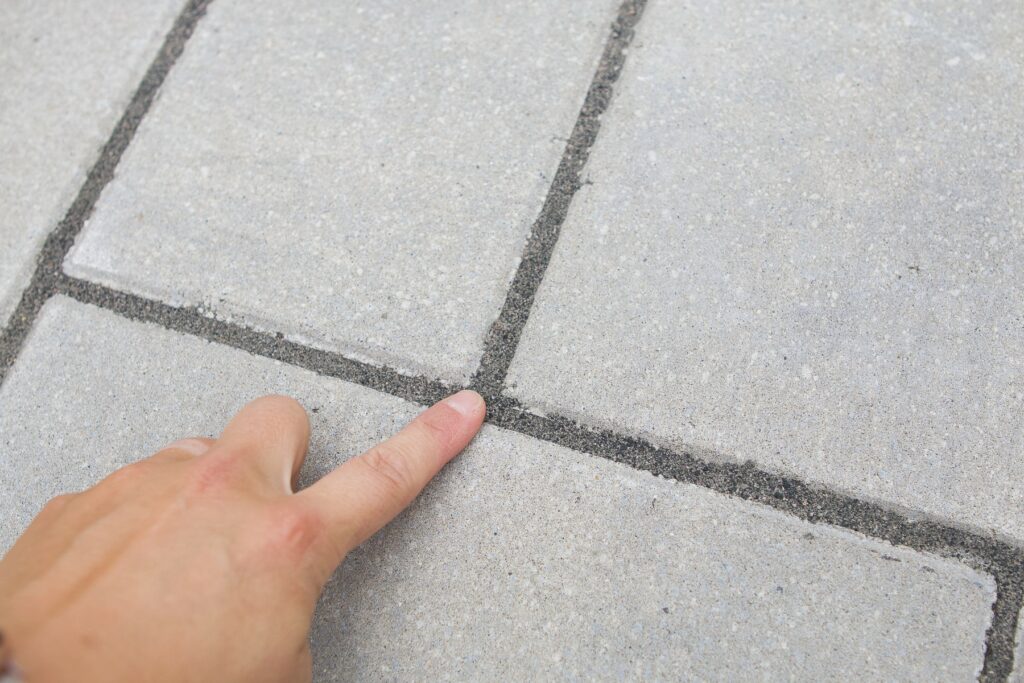
The advantages of polymeric sand
Now that we’ve established the unique nature of polymeric sand, let’s explore its benefits for your patio:
- Superior weed control: Unlike traditional sand, polymeric sand creates a tightly packed barrier that significantly hinders weed germination and growth. This saves you time and effort on constant weeding, keeping your patio looking pristine.
- Enhanced stability: Polymeric sand locks the pavers in place, preventing them from shifting or becoming uneven due to foot traffic or weather conditions. This translates to a safer, more comfortable walking surface.
- Improved durability: The resin binder in polymeric sand resists erosion from rain and wind, ensuring your patio joints stay filled and protected for years to come.
- Reduced maintenance: Polymeric sand minimizes the need for regular joint refilling, saving you time and money on maintenance compared to traditional sand.
- Permeability: While polymeric sand provides a strong bond, it remains permeable, allowing water to drain through the pavers and preventing puddles from forming on your patio.
What is polymeric sand?
Polymeric sand is a specially formulated sand mix that incorporates a polymeric binder and other additives. The binder activates upon contact with water, creating a strong adhesive force that binds the sand particles together and to the edges of the pavers. This creates a stable, weed-resistant, and long-lasting joint filler.
And polymeric sand isn’t just used for patios! It’s a versatile product suitable for various applications, including:
- Walkways: Similar to patios, polymeric sand keeps walkways stable and prevents weed growth, ensuring a safe and attractive path.
- Driveways: While not suitable for high-traffic driveways, polymeric sand can be used for low-traffic applications, providing a stable and attractive surface for smaller driveways or pathways.
- Pool Decks: Polymeric sand helps maintain a clean and stable pool deck surface, minimizing the risk of slips and falls around the pool area.
- Retaining Walls: When used in conjunction with proper wall construction, polymeric sand can help stabilize the joints between retaining wall blocks.
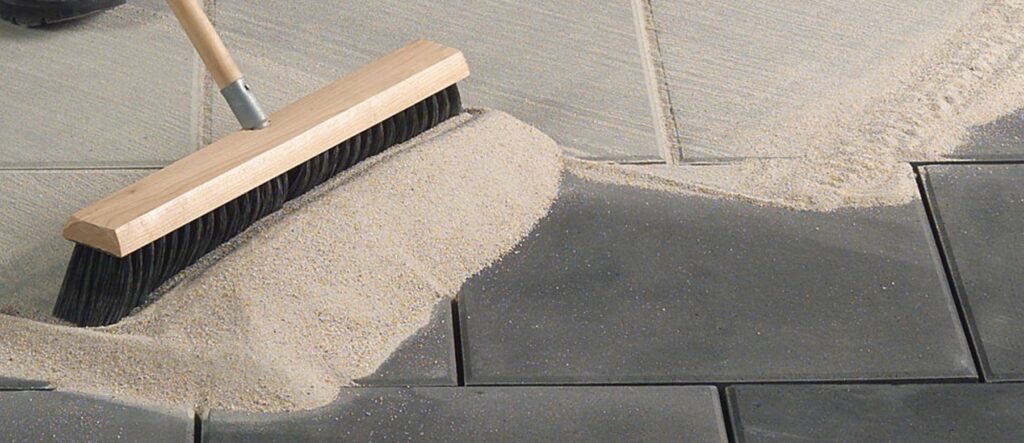
Using polymeric sand on your patio
Here’s a step-by-step guide to using polymeric sand on your patio:
- Preparation: Ensure your pavers are clean, dry, and free of debris. Sweep away any loose particles or dirt from the joints.
- Joint width: Polymeric sand is ideal for joints between 1/8 inch and 2 inches wide. Wider joints may require a combination of polymeric sand and crushed gravel for proper support.
- Apply sand: Pour the polymeric sand onto the dry patio surface, ensuring it fills the joints completely. Use a stiff broom to sweep the sand across the entire area, pushing it into the joints.
- Compact the sand: Once the joints are filled, use a plate compactor (available for rent at most hardware stores) to gently compact the sand. This helps settle the sand and ensure a tight fill.
- Sweeping and removing excess: After compacting, use a broom to remove any excess sand that lies on top of the pavers.
- Activate the binder: Following the manufacturer’s instructions, lightly mist the surface with water using a sprayer with a fine setting. Avoid overwatering, as this can wash away the sand.
- Curing: Allow the polymeric sand to cure completely according to the manufacturer’s recommendations. This typically takes 24 to 48 hours, depending on weather conditions. During this time, avoid walking on the patio or exposing it to heavy rain.
Additional tips for polymeric sand success
- Weather conditions: Don’t apply polymeric sand in extreme heat, direct sunlight, or when rain is imminent. Ideal conditions are mild temperatures with moderate humidity and no rain expected for at least 24 hours.
- Reapplication: Over time, some settling of the sand may occur. If you notice any minor gaps in the joints, simply add a small amount of polymeric sand, sweep it in, and lightly mist it with water to reactivate the binder.
- Safety: Polymeric sand can irritate the skin and eyes. Wear gloves and eye protection while handling the product.
For experienced DIYers, polymeric sand can be used in conjunction with other techniques for a professional-looking finish. Here are a couple of examples:
Polymeric sand with sealant
After the polymeric sand cures, some professionals apply a paver sealant for added protection against stains and fading. However, ensure the chosen sealant is compatible with polymeric sand.
Polymeric sand for uneven pavers
In some cases, minor unevenness in paver heights might exist. Polymeric sand can be used in combination with a polymeric leveling compound to address slight height discrepancies and create a smoother surface.
How to choose the right polymeric sand
With various brands and formulations available, choosing the right polymeric sand for your project is crucial. Here are some factors to consider:
- Different polymeric sand products are designed for specific joint widths. Ensure the chosen sand is suitable for the size of your paver joints.
- Polymeric sand comes in a variety of colors to complement your paver choices. Common colors include beige, gray, and black.
- Opt for a reputable brand known for high-quality products. Reading online reviews and consulting with professionals at your local hardware store can help narrow down your options!
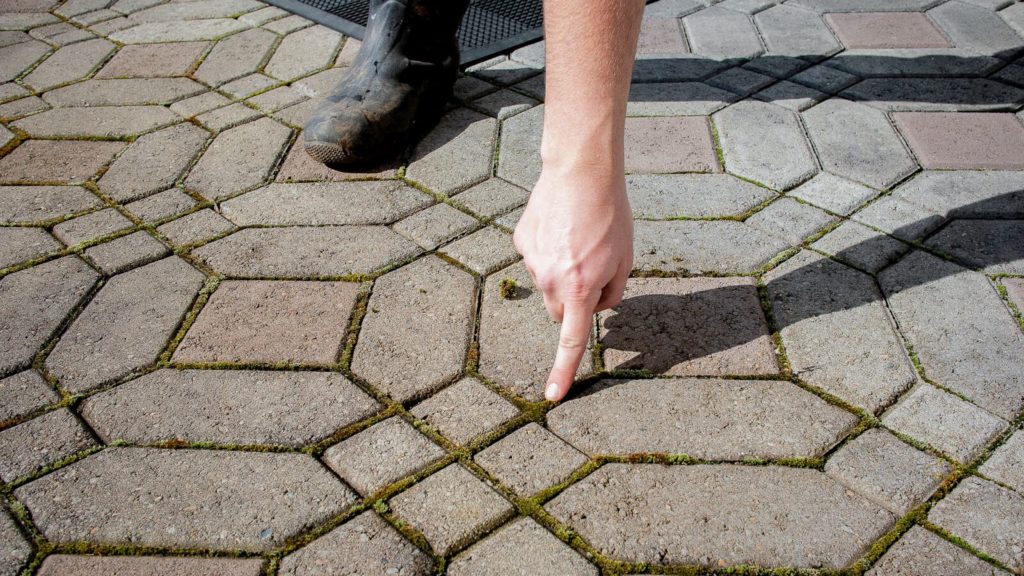
So – does polymeric sand harden like concrete? No, but that doesn’t make it unusable!
We hope this article was able to answer the question if polymeric sand hardens like concrete. You know now that not being as hard as concrete is not actually an issue! After our article, we are sure you were able to understand all the positive points of polymeric sand.
In all truth, polymeric sand offers a clear advantage over traditional sand for filling paver joints on your patio. Its unique properties provide superior stability, weed control, and durability, translating to a beautiful, low-maintenance outdoor space.
While it doesn’t harden like concrete, the polymeric binder creates a strong and flexible bond, keeping your patio looking its best for years to come. So, for a lasting and functional patio solution, consider polymeric sand as your go-to choice.
If you are struggling to apply polymeric sand to your pavers, just let S&S Pavers handle it for you! With over 10 years of expertise in installing distinctive pavers in Sarasota and Manatee, we’re ready and eager to assist. Contact us today to ensure your patio looks stunning for years to come!


